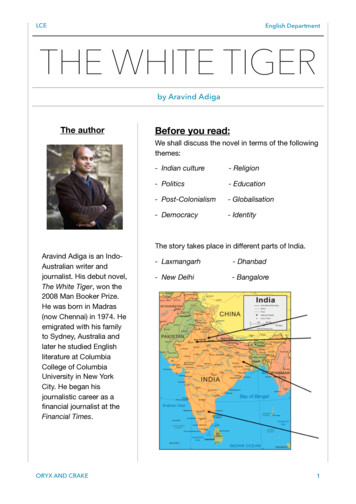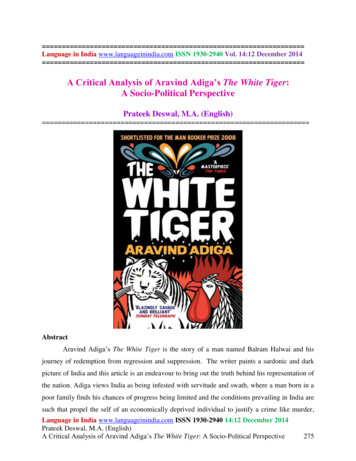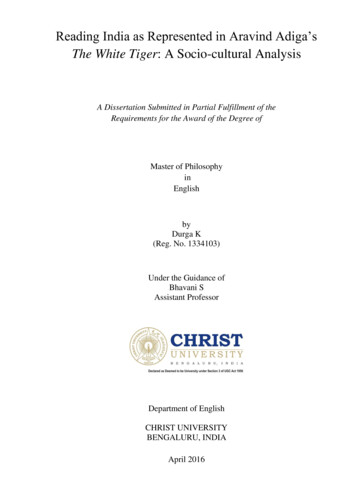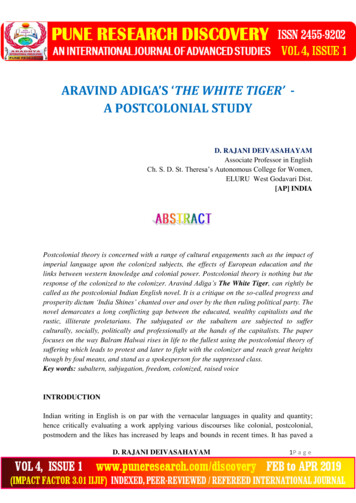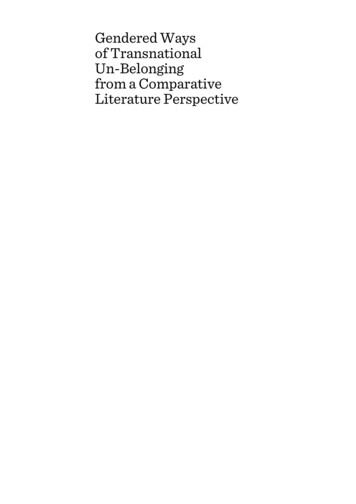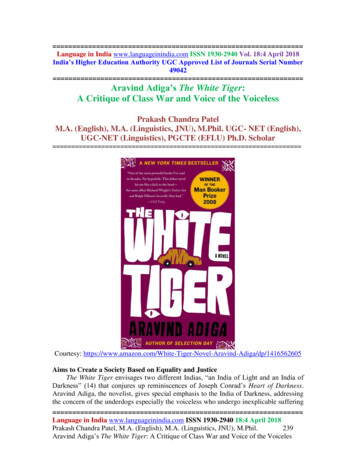
Transcription
Language in India www.languageinindia.com ISSN 1930-2940 Vol. 18:4 April 2018India’s Higher Education Authority UGC Approved List of Journals Serial Number49042 Aravind Adiga’s The White Tiger:A Critique of Class War and Voice of the VoicelessPrakash Chandra PatelM.A. (English), M.A. (Linguistics, JNU), M.Phil. UGC- NET (English),UGC-NET (Linguistics), PGCTE (EFLU) Ph.D. Scholar Courtesy: diga/dp/1416562605Aims to Create a Society Based on Equality and JusticeThe White Tiger envisages two different Indias, “an India of Light and an India ofDarkness” (14) that conjures up reminiscences of Joseph Conrad’s Heart of Darkness.Aravind Adiga, the novelist, gives special emphasis to the India of Darkness, addressingthe concern of the underdogs especially the voiceless who undergo inexplicable suffering Language in India www.languageinindia.com ISSN 1930-2940 18:4 April 2018Prakash Chandra Patel, M.A. (English), M.A. (Linguistics, JNU), M.Phil.239Aravind Adiga’s The White Tiger: A Critique of Class War and Voice of the Voiceles
owing to utter discrimination between “Big Bellies and the Small Bellies” (64). This“riveting, razor-sharp debut novel explores with wit and insight the realities of these twoIndias, and reveals what happens when the inhabitants of one collude and then collidewith those of the other.” (Bhattacharya).The novelist attempts to highlight the malaise that has plagued the Indian society.The social framework has been formulated in such a way that the poor accept the illtreatments and traumatic experiences they suffer in the hands of the rich or elite class as apart of their social norms. In a bid to assert their superiority, the elitist mindsets,consciously or unconsciously although most of the time consciously, direct the pent upanger at the poor and the underclass, crush their spirit and choke their voice to make themvoiceless, severely jeopardize their inner self, and thus in reality flirt dangerously withthe rights and liberties they are entitled to.Adiga aims to create a society based on equality and justice. Balram Halwai is thevoice of the voiceless, described in the novel to be in the trap of “Rooster Coop” (173),and he makes strenuous efforts to break free from the shackles of age old traditionallysanctioned “slavery and exploitation” (Singh) at the expense of conscience even of theconscientious ordinary. This is gravely concerned to take it for granted in that socialattitude of this sort may create thousands of Balrams who represent a real danger to thepolitical and economic landscape, and can inflict serious damage on the social fabric andmoral fibre of the nation.The White TigerThe White Tiger, the debut novel by Indian novelist, Aravind Adiga, was publishedin 2008 to win the 40th Man Booker Prize though fourth from Indian perspective.Considered a darkly humorous novel, it takes into account the journey of an Indianvillager from rags to riches by one means or another doing justice without a secondthought to Machiavellian means to achieve the ends. As an epistolary novel, it gives athorough perspective of India’s class struggle between the haves and the have nots,retrospectively narrated in the form of letters by Balram Halwai, the protagonist to theChinese Premier His Excellency Wen Jiabao during seven nights. In his letter to thepresident of China against the backdrop of his visit to Bangalore, he makes the detailedmention of his transformation and experience as a driver and a servant to become anIndian opulent class. In the wake of IT revolution and “vertiginous economic growth, theburgeoning of an aggressively consumerist, astonishingly wealthy urban elite and the riseof the bellwether stock-market index” (Bhattacharya), India is at a crossroad to deal withthe deep divide between the rich and the poor.Perfect NovelAs Michael Portillo, Chairman of the judges of Man Booker Prize said.In many ways it was the perfect novel. The judges found the decisiondifficult because the shortlist contained such strong candidates. In the end,The White Tiger prevailed because the judges felt that it shocked and Language in India www.languageinindia.com ISSN 1930-2940 18:4 April 2018Prakash Chandra Patel, M.A. (English), M.A. (Linguistics, JNU), M.Phil.240Aravind Adiga’s The White Tiger: A Critique of Class War and Voice of the Voiceles
entertained in equal measure. The novel undertakes the extraordinarilydifficult task of gaining and holding the reader's sympathy for athoroughgoing villain. The book gains from dealing with pressing socialissues and significant global developments with astonishing humour. Portillowent on to explain that the novel had won overall because of its originality.He said that The White Tiger presented a different aspect of India and was anovel with enormous literary merit.Examines Issues of Religion, Caste, Loyalty, Corruption and PovertyEven as “an amazing and angry novel about injustice and power” (Donahue), TheWhite Tiger rigorously examines issues of religion, caste, loyalty, corruption and povertythat has spilled over into every echelons of the society in India. As though to expose thedangerous hypocrisy of the rich, from the politicians to the police and the upper class,termed more often than not as the elite, the novel sheds light on the ruthless exploitationof the poor and the needy who in return devote all their energy to the happiness andenjoyment of their master, easily ready to treat this servitude almost in utter disgust andmanoeuvre them into their whims obnoxiously, once the occasion arises.Adiga says in an interview,At a time when India is going through great changes and, with China, islikely to inherit the world from the west, it is important that writers like metry to highlight the brutal injustices of society. That's what writers likeFlaubert, Balzac and Dickens did in the 19th century and, as a result, Englandand France are better societies. That's what I'm trying to do - it's not an attackon the country, it's about the greater process of self-examination. (Jeffries)Protagonist Balram - The Voiceless Forms a Dark IndiaFor success in his life, Balram never baulks at crime and violence, and he resortsat the drop of a hat to anger, protest, criminal acts, prostitution, drinking, chasing,grabbing all the opportunities fair or foul, no matter what serious repercussions he has tosuffer. A son of a rickshaw puller and the driver of an elite class, Balram is subjected toall sorts of ill treatment and severe mental torture that makes him spirited, as if invengeance, to voice for the underclass including marginal farmers, landless labourers,jobless youths, poor, auto and taxi drivers, servants, prostitutes, beggars and unprivilegedfigures. The aberration in various sectors- wrong policy, red tapist unaccountablebureaucratic set-up, poverty, illiteracy, unemployment, caste and culture conflict,superstitions, social taboos, dowry practice, economic disparity, faulty education system,poor health care system, corrupt police and judicial malfunctioning- accounts for allthese problems, devoicing the downtrodden and the underprivileged forever. Thewidening gap between the rich and the poor is on the rise, leading to social injustice andinequality. So proliferate and ingrained are they that they are no stranger to us, ratherthey have become an integral part in our daily existence. Social maladies, violence,rancorous attitude and backbiting have been the order of the day. As a result, theeconomic framework has been such that a miniscule of society prospers and enjoysthemselves at the cost of a large majority. Thus the voiceless forms a Dark India. Language in India www.languageinindia.com ISSN 1930-2940 18:4 April 2018Prakash Chandra Patel, M.A. (English), M.A. (Linguistics, JNU), M.Phil.241Aravind Adiga’s The White Tiger: A Critique of Class War and Voice of the Voiceles
Kiran Desai and AdigaBoth Kiran Desai’s The Inheritance of Loss and Aravind Adiga’s The White Tigerattribute the root cause of social violence to marginalization and discrimination due toyawning gap between the rich and the poor. The philosophy of Franz Fanon has profoundinfluence on Adiga to believe that economic disparity and social inequality are theunderlining reasons for frustration, depression and revolution either at social or individuallevel. Such widening gap amounts to unrelenting bitterness, constant class war andabsence of human relationships, and the voiceless are vulnerable to a large extent.Balram Halwai, the White TigerThe economic inequality and consequential oppression is so acute in the society thatthe poor class develops an inferiority complex of servitude like Balram who tries to getrid of his slavery by doing something that may prick the conscience of a sensible person.Balram Halwai, a poor Indian villager is the White Tiger, a rare creature “that comesalong only once in a generation”(30). It is a name given to him by a government schoolinspector because of his promising talent and considerable intelligence. He makes adeliberate effort to search for his identity and his existence in this world as seen inprevious Indian novelists like Mulk Raj Anand’s Bakha, and Coolie, and Tagore’s Gora.As mentioned by him, his parents, almost groaning under grinding poverty, hardly botherto give him a true name and calls him ‘Munna’ which means ‘a boy’. Shocked at hisnamelessness, his school teacher, Mr. Krishna dubs him as ‘ Balram’. Bitterlyexperienced with the ruthless dominance of the landlords in his village, his father, even asa rickshaw puller, sends him to school to escape their atrocities, but poverty deters himfrom continuing notwithstanding sheer scholastic talent; rather drives him to work in ateashop where he receives his education, albeit in an informal way, eavesdropping oncustomers’ conversations. Here is an analytically realistic account of degraded systemicfailures.Adiga thus through the voice of protagonist says in his novel The White Tiger as:Me, and thousands of others in this country like me, are half-baked, becausewe were never allowed to complete our schooling. Open our skulls, look inwith a penlight, and you'll find an odd museum of ideas: sentences of historyor mathematics remembered from school textbooks (no boy remembers hisschooling like the one who was taken out of school, let me assure you),sentences about politics read in a newspaper while waiting for someone tocome to an office, triangles and pyramids seen on the torn pages of the oldgeometry textbooks which every tea shop in this country uses to wrap itssnacks in, bits of All India Radio news bulletins, things that drop into yourmind, like lizards from the ceiling, in the half hour before falling asleep—allthese ideas, half formed and half digested and half correct, mix up with otherhalf-cooked ideas in your head, and I guess these half-formed ideas bugger Language in India www.languageinindia.com ISSN 1930-2940 18:4 April 2018Prakash Chandra Patel, M.A. (English), M.A. (Linguistics, JNU), M.Phil.242Aravind Adiga’s The White Tiger: A Critique of Class War and Voice of the Voiceles
one another, and make more half-formed ideas, and this is what you act onand live with ( TWT 10-11).Besides, the memory of his mother’ s death and the aftermath is horrible for all thedays to come. For Balram, lavish grandeur of her funeral is starkly opposed to the abjectmisery, she endured while alive that the “family was guilty about something” (13). Thismisery is compounded by heartbreaking moments of his father’s miserable death at theinadequately staffed hospital. Commenting on the lackadaisical attitude of the politiciansknown as “Great Socialist” for rural health care system, he ironically informs “there arethree different foundation stones for a hospital, laid by three different politicians beforethree different elections” (39), noticeably marking the striking dichotomy between therural and the urban. His village, Laxmangarh, engulfed in poverty and social maladies,stands for “Darkness” as against “the Light” (11). All these experiences contribute to thegrowth of his enigmatic personality.Caste SystemThe caste system as well as social hierarchy is minutely detailed by the author.There is a sharp discrepancy between the poor and the rich, the old and the new. Balram,as a new appointment in Stork family suffers sheer discrimination not just by the familybut by the previous driver. The family asks him to drive standard Maruti Suzuki andtreats him with reckless disregard as the second driver while the first driver is givendesirable Honda City. Both of the drivers stay in appalling conditions. Balram’s conditionis worse in as much as he has to sleep on the floor where as the first driver occupies thebed. Though officially hired as a driver, he is instructed to do varied household menialtasks, including the most humiliating job of massaging the Stork's feet in warm water thatpains him excruciatingly. As a driver, Balram has opportunity to move to New Delhi withMr. Ashok and his wife Pinky Madam and access to dungeon of rampant corruption inIndian society thus. The government sector is no exception but stands supreme in thisregard. As observed, the deep and dangerous divide between the rich and the poor is notonly evident at the village level but ostensibly prevailing even in the city like New Delhi.Here also, the mental trauma continues unabated. Moreover, the refusal of entry to themall, treating him as a servile lackey, burdening him with bags and baggage, indulginghim in his master’s corrupt practices and lecherous activities and so on add insult toinjury and put a damper on his human spirit. What is stored in him is deep angst andanimalistic rage.In one incident, Pinky the wife of Ashok kills a child in reckless drunken drivingand the family makes an abominable decision to frame Balram for the hit and run case.Thus he is forced to admit the crime that he did not commit by signing this documentTO WHOMSOEVER IT MAY CONCERNI, Balram Halwai, son of Vikram Halwai, of Laxmangarh village in thedistrict of Gaya, do make the following statement of my own will andintention: Language in India www.languageinindia.com ISSN 1930-2940 18:4 April 2018Prakash Chandra Patel, M.A. (English), M.A. (Linguistics, JNU), M.Phil.243Aravind Adiga’s The White Tiger: A Critique of Class War and Voice of the Voiceles
That I drove the car that hit an unidentified person, or persons, or personand objects on the night of January 23rd this year . That I was along in thecar, and alone responsible for all that happened.I swear by almight God that I make this statement under no duress andunder instruction from no one (TWT 167).It was his sheer luck that no one reports the missing child. Even as mentioned byAdiga in The White Tiger, this is unbelievably true that the jails in Delhi are full of drivers who are there behind bars because theyare taking the blame for their good, solid middle-class masters. We have leftthe villages, but the masters still own us, body, soul and arse. (TWT 169)Lingering Mental BitternessThe horrendous experience of lingering mental bitterness and ruthless treatment,unleashed by the obnoxious be all and end all mentality of the upper class is in factagonizing. That Mongoose, brother of Mr. Ashok in his trip back to village, loses a onerupee coin while getting out of the car flirts dangerously with the essence of Balram’sinner self that remains amorphous in the face of the rich. So mean and ridiculous is hethat he asks Balram to search for it much to the heartrending disgust of the later whosounds distraught as if almost an identity less. Mongoose is at his most outrageous, whenhe points the finger of suspicion at the driver. Adiga writes:‘Get down on your knees. Look for it on the floor ofthe car. ’I got down on my knees. I sniffed in between the mats like a dog, allin search of that one rupee.‘What do you mean, it’s not there? Don’t think you cansteal from us just because you’re in the city. I wantthat rupee.’ ‘We’ve just paid half a million rupees in a bribe, Mukesh, andnow we’re screwing this man over for asingle rupee. Let’s go up and have a scotch.’ ‘That’s how you corruptservants. It starts with one rupee. Don’t bring your American ways here.’Where that rupee coin went remains a mystery to meto this day, Mr Premier. Finally, I took a rupee coin outof my shirt pocket, dropped it on the floor of the car,picked it up, and gave it to the Mongoose. (TWT139)A Matter for Ridicule – Rural Background and PronunciationThis is done by a person who spends millions in bribe. Besides, Balram is made alaughing stock because of his rural background as in the pronunciation of ‘mall’ and‘Pizza’ or simply for their entertainment and enjoyment as in the episode of dressing himlike a Maharaja just for the sake of pandering to Pinky’s whims and fancies. He is alsowarned not to switch on AC or play music when alone. All these incidents pave the way Language in India www.languageinindia.com ISSN 1930-2940 18:4 April 2018Prakash Chandra Patel, M.A. (English), M.A. (Linguistics, JNU), M.Phil.244Aravind Adiga’s The White Tiger: A Critique of Class War and Voice of the Voiceles
for his criminal bent to flourish and become the breeding ground for blatant conspiracy,treacherous plot or nefarious scheme in an effort to fulfill his overriding ambitions andboost his business dealings. Thus, the utter humiliation that Balram suffers as a driver dueto Mongoose, Pinky Madam, Mr Ashok and many others stimulates his animal instinct tokill Ashok, when the occasion arises.A Gift for Irreverence and Dedication to the Cause of the PoorAdiga’s style of unflinching gift for irreverence brings out an excoriatingtreatment to the credos. Indian business, education, administration, religion and securitycome under rigorous scrutiny. The following passage is apt and illuminating.Apparently, sir, you Chinese are far ahead of us in every respect, except thatyou don’t have entrepreneurs. And our nation, though it has no drinkingwater, electricity, sewage system, public transportation, sense of hygiene,discipline, courtesy, or punctuality, does have entrepreneurs. (TWT 4)Vigorously exploring the class war in an attempt to give a voice to theunderclass at a time of modernization and globalization, this novel paints a bleak pictureof India, paralysed by greed, nepotism, corruption and violence at all levels. Adiga’sportrayal of India stands in stark contrast to Rudyard Kipling’s exoticized view andemblematic example. India in The White Tiger receives an unconventional andunflattering treatment. Even critics like Anjali Kapoor imputes an allegations ofjaundiced eye to Adiga who presents a distorted picture of India “focusing on everythingthat is bad and disgusting” like Naipaul who hankers for “talking contemptuously aboutIndia, about how cleaners mop the floor in restaurants by crouching and moving likecrabs and all that talk about Indians defecating in the open.” (Kapoor)Placing strong emphasis on the participation of public in the success andeffectiveness of popular organization and democratic institution, Jean Dreze and AmartyaSen voice concern about “the adverse effects of social inequality on democratic practice”.They underline the fact “that while the quality of democracy is often compromised bysocial inequality and inadequate political participation, democratic practice itself is apowerful tool of elimination of these handicaps” (Dreze). Adiga is quite right when hetries to justify that social inequality and economic disparity are the source of all evils.Expression of Author’s AngerAsked whether it is the anger of Adiga himself, Adiga answers as follows:The novel is written in “voice”—in Balram’s voice—and not in mine. Someof the things that he’s confused by or angry about are changes in India that Iapprove of; for instance, he is uncomfortable with (as many men like himare) the greater freedom that women have in today’s India. Some of the otherthings he’s unhappy about—like corruption—are easier for me to identifywith. When talking to many men whom I met in India, I found a sense of Language in India www.languageinindia.com ISSN 1930-2940 18:4 April 2018Prakash Chandra Patel, M.A. (English), M.A. (Linguistics, JNU), M.Phil.245Aravind Adiga’s The White Tiger: A Critique of Class War and Voice of the Voiceles
rage, often suppressed for years and years, that would burst out when theyfinally met someone they could talk to. But their anger was not the anger of aliberal, middle-class man at a corrupt system; it was something morecomplex—a blend of values both liberal and reactionary—and I wanted to betrue to what I’d heard. Balram’s anger is not an anger that the reader shouldparticipate in entirely—it can seem at times like the rage you might feel ifyou were in Balram’s place—but at other times you should feel troubled byit, certainly.(Nick)Consequent upon enormous economic disparity, social inequality and endemiccorruption, the democracy is at risk and administrative set up is likely to deteriorate. Thepoor are at the receiving end. The election rigging and political opportunism, as describedin the novel, is no longer a new phenomenon. It is heavily paradoxical that those,aggressively advocating for political integrity, cannot remain aloof from politicalquagmire, once they join politics, take responsible jobs or are at the helm. Vijay, busconductor turned politician and the role model and inspirational figure for Balram,indulges himself with corrupt practice, dishonesty and violence. Ultimately, theunderclass or the poor falls victim to these social and political anomalies through no faultof their own.The Dark Side of the Business WorldStaying with Ashok, Balram comes to know the dark side of his business worldand he learns the tricks to escape. Infectiously, he himself knows the way to siphon gas,handling corrupt mechanics and refill and resell Johnnie Walker black label bottles.As man of considerable cunning and ingenuity, Balram can easily sense thecorrupt practices prevailing in the social, political and cultural system. Corruption,bribery and nepotism grow by lips and bounds. The education system which is entrustedwith the responsibility of building the career of the students and shaping the future of thenation has fallen into disarray due to corruption, mismanagement and financialirregularity. Mr. Krishna embezzles the government allocated fund meant for the purposeof uniforms and lunch of the students. The bribery by Mr. Ashok to get coal mine is seenand experienced by Balram. Quid pro quos are essence of the politicians or the person ofpolitical affiliations. Corruption and scandals hit the headlines in India every day. It is sorampant and wide spread that “there are few to whom India's corruption will come as asurprise.” (Segal )In the programme “You ask the question,” Adiga, in response to a query on poorcondition, internal unrest and terrorism in India, said:These problems have been brewing for a long time. The causes are complex,but one common theme I find is the heightened tension within the countrythat's caused by the growing gap between the rich and the poor. The flare-upscan often take the form of ethnic or regional protests, but the underlyinggrievances are often economic: "those people who live over there are doing Language in India www.languageinindia.com ISSN 1930-2940 18:4 April 2018Prakash Chandra Patel, M.A. (English), M.A. (Linguistics, JNU), M.Phil.246Aravind Adiga’s The White Tiger: A Critique of Class War and Voice of the Voiceles
much better than we are." Fixing the economic disparities has to be part ofany attempt to address India's growing unrest. The country's intelligence andpolice agencies need to be reformed and modernised; right now they seemway behind the terrorists. (Adiga)The Dominant Class Conscious MentalityAccording to Balram, the dominant class conscious mentality has a prime role toplan and construct for the poor a “Rooster Coop” which is described as:Hundreds of pale hens and brightly coloured roosters stuffed tightly into wiremesh cages, packed as tightly as worms in a belly, pecking each other andshitting on each other, jostling just for breathing space; the whole cage givingoff a horrible stench. The roosters in the coop smell the blood from above.They see the organs of their brothers lying around them. They know they arenext, yet they cannot rebel. They do not try to get out of the coop. The verysame thing is done with humans in this country. (TWT173-174)He also lays the blame on the mentality of the servant class who suffers “perpetualservitude” without making any effort to wriggle out of this situation. As mentioned:“one can put the key of his emancipation in a man’s hands and he will throwit back at you with a curse”. (TWT 147)Mirza Ghalib’s line ‘They remain slaves because they can’t see what is beautiful inthe world’ (40), provides Balram with food for thought, dose of inspiration and the desireto be a free bird. Besides, his visit to his native village whets his appetite for freedom. It was a very important trip for me while Mr. Ashok and Pinky Madamwere relaxing I swam through the pond, walked up the hill and enteredthe Black Fort for the first time Putting my foot on the wall, I looked downon the village from there. My little Laxmangarh. I saw the temple tower, themarket, the glistening line of sewage, the landlords’ mansion – and my ownhouse, with that dark little cloud outside – the water buffalo. It looked likethe most beautiful sight on earth. I leaned out from the edge of the fort in thedirection of my village – and then I did something too disgusting to describeto you. Well actually, I spat. Again and again. And then, whistling andhumming, I went back down the hill. Eight months later, I slit Mr. Ashok’sthroat (TWT.41-42).To Break Out of the Rooster CoopUnstinting individual effort with ferocious determination, exemplified by him, isthe need of the hour to break out of the “Rooster Coop”. Thus he thinks he can manage todo away with India’s “Rooster Coop” by killing and robbing Mr. Ashok. Balram isacutely aware of the fact that the brutal murder of Mr. Ashok will put in serious jeopardy Language in India www.languageinindia.com ISSN 1930-2940 18:4 April 2018Prakash Chandra Patel, M.A. (English), M.A. (Linguistics, JNU), M.Phil.247Aravind Adiga’s The White Tiger: A Critique of Class War and Voice of the Voiceles
his family who has to face the fiery wrath of the Storks or fall prey to their bloodyvengeance. Nonetheless, he never allows his emotions to come in the way of therelentless pursuit of “his own uncaring ambition” (Singer) and irresistible desire. Heconsiders himself “a self-taught entrepreneur” (4), represents, as he himself mentions,“tomorrow” (319) and stands for the voice of the voiceless.Some treats Balram as a typical psychopath or sociopath who according to Copley“selects a course of action based on only one factor—what can he get out of it. This coldblooded mode of reasoning enables the psychopath to commit acts that most people’sconsciences would not allow”. But Balram is not a psychopath rather he is someonedeeply frustrated by the social system. He develops a sense of social exclusion beingunder the combined spell of disillusion of the social institutions and ill treatment andmisbehaviour of Mr.Ashok and his social circles. To do illegal things to achieve his selfcentered aims does not seem uncommon to him in such an environment.As a driver of Mr. Ashok, he gives a one rupee coin to a little street beggar evenagainst the reproachable gesture of one of his masters. This shows Balram is a man ofboth considerate mentality and devil may care attitude. Pinky Madam, with the departureof Mongoose, wears those clothes that are revealing in the extreme. Balram feelsattracted and fiercely turned on, nevertheless he manages to get to grips with theemotions, and excitement cannot hold sway over his sensibility. This shows he is not aperson of whims and fancies but a man of sense and reason, as time demands. Besides, henurtures a fellow feeling for the drivers in his taxi business that psychopath cannot. Evenas he successfully handles the crisis in the wake of a boy’s death using his ingeniouslydesigned tricks and bribing police to take control of the situation, if flared up, he pays avisit to the victim’s family, apologizes for the incident, offers some consolable amountand assures a job in his business for one of the survival member. He knows Mr Ashok isnot as bad as others but it is Hobson’s choice on his part to kill him to execute his plan inBanglaore, for which he feels regret sometimes.Moreover, as stated, Balram, as a rickshaw puller’s son is raised in a typical poorfamily in India. He is thus from a family where men and women sleep in opposite cornersof the house. With his harrowing experience against the backdrop of a large family,impoverished background in his village and painful humiliation as a driver in the handsof the upper class, it is natural for him to be desperate for a change. In this sense, he hasto transform into a newversion of Nietzsche’s "ubermensch," or over-man, whobelieves himself t
The White Tiger, the debut novel by Indian novelist, Aravind Adiga, was published in 2008 to win the 40th Man Booker Prize though fourth from Indian perspective. Considered a darkly humorous novel, it takes into account the journey of an Indian villager from rags to riches by one means or another doing justice without a second .

